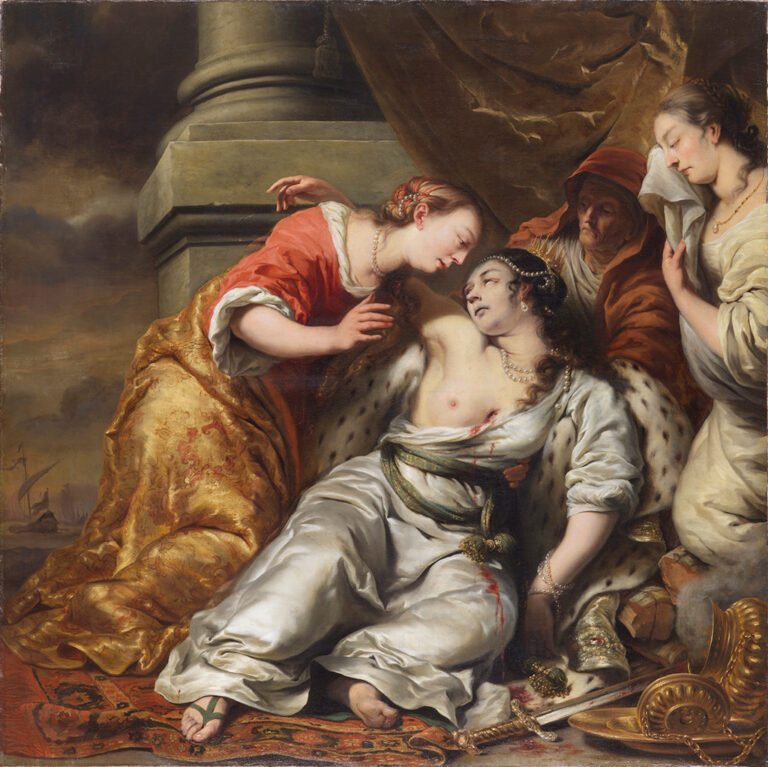With theatrical bravura, Ferdinand Bol depicted the climax of one of the most tragic love stories in classical literature, recounted in the fourth book of Virgil’s Aeneid.1 Dido, the beautiful queen of Carthage, and Aeneas, the Trojan prince who had survived the ravages of his besieged city, fell deeply in love after the shipwrecked hero landed on Carthage’s shore.2 Their love, however, was doomed from the beginning, for Aeneas was destined to be the founder of Rome, and his fortunes lay elsewhere. When the gods reminded the prince of his important duty, he had no choice but to leave. Grief-stricken by Aeneas’s departure and mortified at having broken her oath of faithfulness to her dead husband, Sychaeus, the ruined queen burned all her lover’s possessions, climbed onto the pyre, pierced herself with Aeneas’s sword, and died.
Bol poignantly rendered the last moments of Dido’s life against the backdrop of a monumental column, partially covered by a billowing, velvet curtain. On a sumptuous carpet, the dying queen, supported by the old nurse Barce, makes one last effort to look into the eyes of her younger sister Anna, who raises her right arm in despair as she tries to hold Dido’s gaze. At the far right, Anna’s maid Melinda quietly holds a handkerchief to her eyes in a moment of private grief. Dido’s lopsided crown, her broken pearl necklace, and the way her dress has slipped down to reveal her right breast and the gaping hole of the mortal wound in her chest all convey a fallen woman at her darkest hour. Aeneas’s sword lies glistening in the foreground, while smoke rises from an urn alluding to the pyre on which Dido will be cremated. Aeneas’s departing ship, seen in the far left distance, provides a painful reminder of the cause of this tragedy.
Bol emphasized the interaction between the dying queen and her inconsolable sister through their compositional prominence and their strongly highlighted jewels and dresses. Not only does Anna express the desperate sentiment of irretrievable loss as she leans toward Dido, but her rosy complexion, red dress, and shimmering golden mantle offer a poignant contrast to Dido’s deathly pale skin and ashen lips, bloodstained silver dress, and white ermine robe. Barce and Melinda, on the other hand, take on secondary roles. Barce’s face is almost entirely obscured in shadow while Melinda is placed at the far right of the composition, physically separated from the central protagonists.
Although other scenes from the Aeneid were relatively common in Dutch painting, including in Bol’s own oeuvre, the subject of Dido’s death gained popularity only in the second half of the seventeenth century.3 Bol looked closely at the composition of a 1643 engraving by Michel Dorigny (1617–65) after the painting Death of Dido by Simon Vouet (1590–1649) (fig 1), and modeled the setting after the French prototype.4 Bol also lifted a number of details from Dorigny’s print, such as Dido’s pose, her dress revealing her proper right breast, the (mirrored) figure of Barce, the creased carpet, the urn on the right, the column and curtain in the right background, and the fleet in the left background.
The striking eye contact between Dido and Anna in Bol’s dramatic interpretation of this scene, however, appears to have been derived from a later, nonpictorial source: the 1668 play Didoos Doot (Dido’s Death), written by the Amsterdam playwright Andries Pels (1631–81).5 In Dorigny’s print, which followed Virgil’s Aeneid, there is no eye contact between Anna, who leans on her sister’s lap as she dries her tears with her dress, and Dido. In Pels’s dramatic reenactment of the classical drama, he deviates from Virgil on precisely this aspect, writing explicitly that Anna cries out one final request: “Oh Dido, Dido, look at your sister once more!”6
By 1668, Bol belonged to the artistic elite of Amsterdam and would have known Pels, a fellow proponent of the classicist style. It is thus likely that Bol saw Pels’s Didoos Doot at the famous Amsterdam Schouwburg, which had reopened in 1665 after a large-scale renovation, and based the interaction between the sisters in his painting on the theatrical performance.7 The painting style of Death of Dido is consistent with Bol’s monumental treatment of classical history painting in the 1660s. He must have executed this work shortly after Pels’s play was first performed, and certainly by 1669, the year in which he completed his last dated painting.8
Like most stories from classical antiquity, the episode of Dido’s suicide had a didactic and moralizing connotation in the Dutch Republic. In Pels’s dedication, addressed to the burgomaster and the Amsterdam city council, he wrote that he intended his play not only as an entertainment for the citizens but also as a tool for moral instruction.9 After all, as the inscription under the frontispiece admonishes, “unlawful and impetuous love will always be punished.”9 Dido was thus judged much more harshly than was Lucretia, her virtuous counterpart whose rape and subsequent suicide had also become popular subjects in theater and the visual arts in the 1660s.10 Unlike Lucretia, who died to preserve her honor, Dido tarnished her reputation the moment she took up with Aeneas, dishonoring the memory of her deceased husband.
Given the large scale of the painting and Bol’s powerful foreshortening of Dido’s body, it is likely that Death of Dido originally hung high on a wall in a grand room. Bol’s monumental depiction of this tragic scene not only would have been prestigious and aesthetically pleasing to its original patron, but also would have served as a reminder to act rationally and morally at all times. After all, as Dido’s example blatantly shows, rash and impassioned acts can lead to catastrophe.
